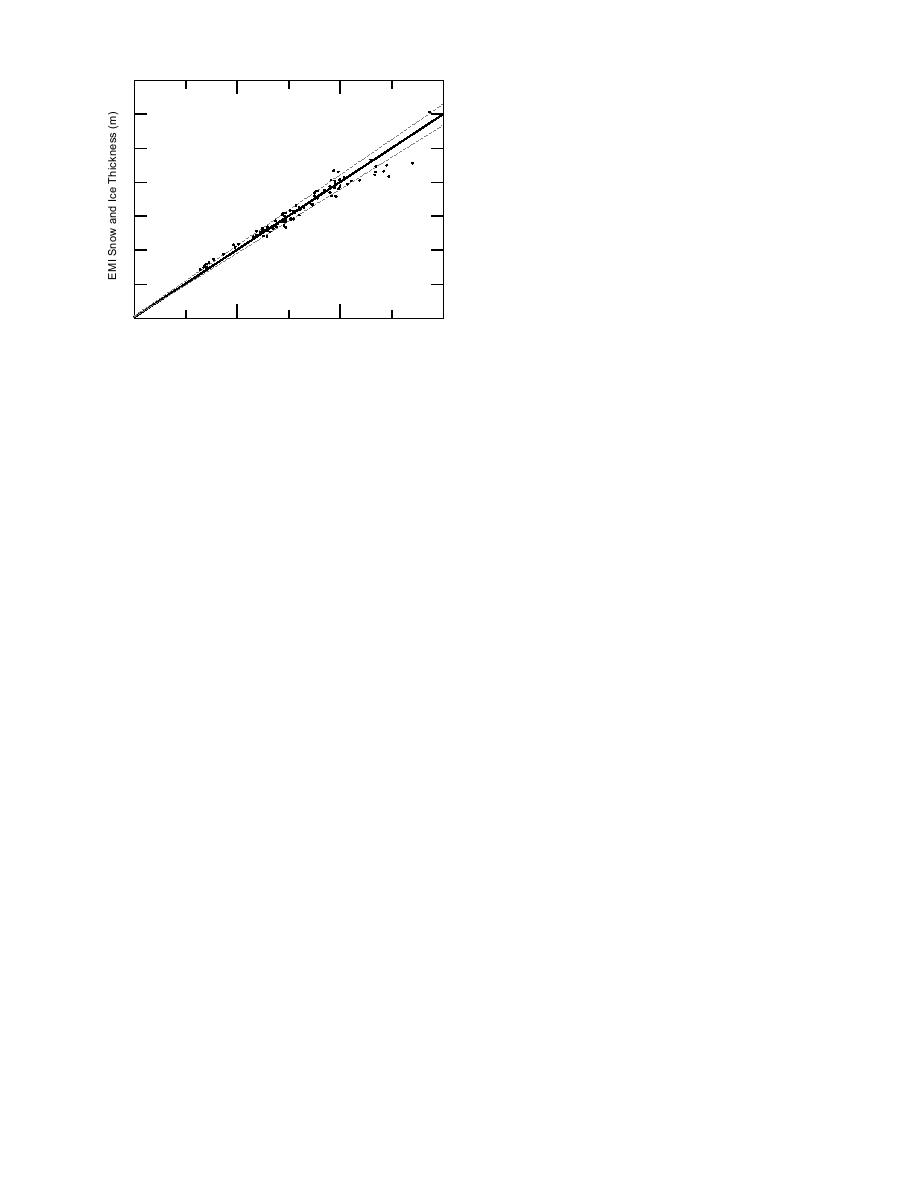
cooled from room temperature to the 40C out-
7
side temperature. After cold soaking the instru-
6
ment for 30 minutes, Gerland and Hass de-
termined that the conductivity reading had
5
5%
apparently decreased to where the estimated ice
thickness was about 5% too low. After an hour of
4
cold soaking, instrument drift was no longer of
significance. It was determined that the drift was
3
largely due to cooling the antenna coils. Our field
measurements were made at much warmer tem-
2
peratures and after the EM-31 had been outside
for well over an hour before being used. While
1
the results of Gerland and Hass are instructive,
their findings are not unexpected.
0
2
4
6
The EM-31 operator's manual (Geonics 1984)
Drill Hole Measured Snow and Ice Thickness (m)
states that "the EM-31 is temperature compen-
Figure 10. A one-to-one linear curve drawn through the
sated and set to read correctly, but due to its high
data shown in Figure 9. Also shown is the 5% vari-
sensitivity, fine adjustment of the instrument gain
ance for the curve.
in the field may be helpful, particularly in the
case of the large changes in ambient tempera-
ture." In short, the instrument should not be used
until it has thermally stabilized, and a calibration
DISCUSSION
adjustment may also be in order if a large tem-
perature change has occurred.
From the results presented in this report, con-
In the EM-31 ice thickness module program, a
ductivity measurements made with a man-
bulk value of 10 mS/m was used for the conduc-
portable EMI can apparently be used to estimate
tivity of the sea ice or the combined snow and sea
Arctic sea ice thickness. This is based on field
ice layer. Slight variations in this bulk value will
conductivity measurements that were found to
not significantly affect the EMI's determined snow
systematically decrease with increasing ice thick-
and ice thickness, but estimated snow and ice
ness. The data indicate that the conductivity read-
thickness will be in error where the snow load
ings can be used to estimate sea ice thickness us-
has depressed the sea ice below sea level and a
ing a simple lookup table or a graph. An EMI
portion of the snow is now saturated with highly
plug-in processor module may also be used to
conductive seawater. The same would be true for
convert the measured conductivity directly into a
rafted ice sheets separated by ice blocks or slush
numerically displayed ice thickness. The ice thick-
ice. In this situation, the layer of seawater or high
ness estimates obtained with the use of the EMI
conductivity slush layer between the ice sheets is
were found to be in good agreement with the drill
not accounted for by the ice thickness module
hole measurements. For sea ice from about 1.5 to
program and the thickness estimate will be in
4.5 m thick, the deviation between the EMI instru-
error.
ment estimated and the drill hole measured ice
thickness was on the order of 5%.
At the 12th International Conference on Port
and Ocean Engineering Under Arctic Conditions,
LITERATURE CITED
held in Hamburg, Germany, during 1720 Au-
gust 1993, S. Gerland and C. Hass of the Alfred
Anderson, W.C. (1979) Computer programs; nu-
Wegener Institute for Polar and Marine Research
merical integration of related Hankel transforms
presented a poster display of the EM-31 conduc-
of orders 0 and 1 by adaptive digital filtering.
tivity measurements they made on sea ice. They
Journal of Geophysical Research, 44: 12871305.
too found good correlation between EM-31 con-
mote sensing of sea ice thickness. Flow Research
ductivity reading and the drill hole measured ice
Co., Inc., Kent, Washington, Flow Research Re-
thickness in areas of nonridged sea ice. However,
port 388.
their EM-31 instrument was found to be tempera-
ture sensitive. In their test, the conductivity read-
Echert, D.C., G.B. White and A. Becker (1989)
ing drifted to lower values as the instrument
Electromagnetic induction sensing of sea ice thick-
7



 Previous Page
Previous Page
